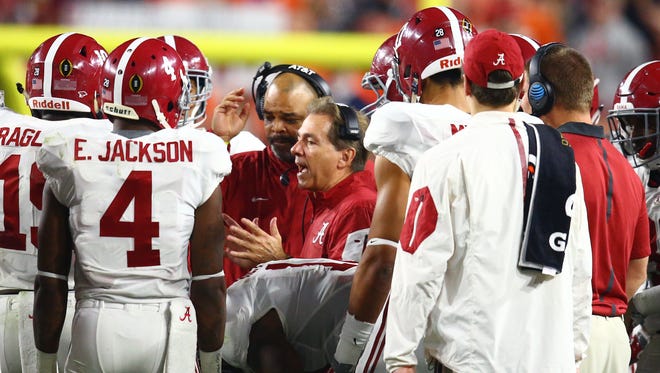How college football defenses are gaining on offenses
By the numbers, 2006 was the strangest defensive season in college football history.

Offenses averaged just 3.07 touchdowns per game, the lowest FBS-wide average since 1992. Teams gained only 346.9 yards per game, the lowest average since 1984. It was a year when defenses across the country dominated at a rate never seen before or since, relative to the era.
So for a few months, at least, defense did indeed win championships — fulfilling the long-held yet flimsy adage preached by uninventive coaches and pundits alike.
In hindsight, that 2006 season was an aberration. Offenses had dominated during the previous half-decade; offenses would dominate the sport even more during the decade following.
A college offense that could challenge the spread's popularity
For years, spread-based and no-huddle offenses have dictated the tempo of games, the flow of action and, far more often than not, the final result. The Southeastern Conference was hesitant to fully embrace the movement, but even that changed: Alabama, among others, embraced a quicker style, needing a more potent offensive attack to maintain its perch atop the sport.
“I still think the spread is a difficult offense,” said Alabama coach Nick Saban. “But I think the rules of college football favor the offense, favor the no-huddle.”
Yet as teams prepare for September, defenses across college football have taken steps toward closing the gap.
Repetition, increased familiarity, tweaked personnel packages and increased communication have helped to turn back time — offenses still rule, but more so than at any point in the last decade, defenses can hold their heads high.
“Defense has adjusted,” said Notre Dame coach Brian Kelly. “Defense has caught up to the lightning no-huddle, the fast-break no-huddle.”
Adjusted, but with a caveat: Defensive numbers will never return to 2006-like levels, let alone those of earlier generations, as more and more teams stress total possessions as their most vital offensive statistic.
“Because we have more snaps, in essence there’s more game,” said Miami (Fla.) defensive coordinator Manny Diaz. “It’s as if baseball went to an 11-inning game and we’re shocked that everyone’s production went up.”
***
For defenses in this era, it’s not about winning the war; the opposition is always going to score points, often in bunches, and rare is the defense that can singlehandedly carry a team to a successful season. It’s about winning individual battles — on third down, for example, or in the red zone.
And no development has played a greater factor in a subtle defensive revival than the proliferation of spread offenses themselves. Ten years ago, a defense might face one or two early adopters of the style during the course of a single season. Now, teams will face an up-tempo opponent more often than not, and in many cases spend an entire year defending the system during practice.
Bragging Rights: USA TODAY Sports College Football Conference Rankings
“The more teams that do that, the more defense is going to study it. The more defense studies it, the more variety of schemes you get,” Arizona coach Rich Rodriguez said.
“What we see now how teams are defending us now are much different than what they were defending 15, 20 years ago just because they see it all the time.”
Yet defenses had been seeing the up-tempo style for years — and had done little to stem the uptick in offensive production. It’s only in the recent past that head coaches and coordinators have found two ways to take advantage of their growing understanding: one, with an increased level of in-game communication, and two, by mirroring offensive shifts with a more tailored approach to defensive personnel.

In the beginning, one of the biggest advantages tempo-based offenses held was in their ability to simply move quicker than the opposition; defenses were unable to maintain the same pace, with that effect snowballing over the course of a single drive, let alone a single game.
“The big thing was their inability to have a defensive structure to handle that fast pace,” Kelly said.
2016 college football TV schedule
Now, defenses have found an ability — thanks in large part to repetition and an increased comfort level — to “communicate effectively their calls,” he said.
In turn, this has allowed defenses to utilize their personnel to match wits with a quick-twitch offense. Several coaches interviewed equated their defensive approach with line changes in hockey: If the opposition sends on three wide receivers, defenses will quickly adapt with multiple defensive backs of their own, for example.
***
This has also led some programs to alter the way they recruit. In the past, Rodriguez would split his team’s 85 scholarships evenly between offense and defense. Recently, however, “it’s been flipping the other way,” he said: Arizona may have as many as 50 scholarships devoted to defense, compared to 30 on offense.

“It's become a little bit of a chess match,” said Rodriguez.
In a sense, however, the fact that defenses have found ways to combat this generation’s offensive explosive shouldn’t be too surprising: In college football as in life, one trend replaces another, so the return of defensive competitiveness may be inevitable.
“The game of football has never been the same for a long period of time,” said Brigham Young coach Kalani Sitake. “It’s rotated quite a bit.”
Offenses still rule, with the final game of last season as evidence: Alabama 45, Clemson 40. Yet as teams find ways to combat what once seemed the unstoppable, it’s possible to envision an era when defenses, not offenses, are again college football’s defining force.
“There’ll be a point in time where the defense is catching up and there will be some new scheme or technique that people are using defensively,” California coach Sonny Dykes said. “It's all cyclical. Football's cyclical.”
Contributing: Daniel Uthman, George Schroeder.
USA TODAY SPORTS PRESEASON ALL-AMERICANS
